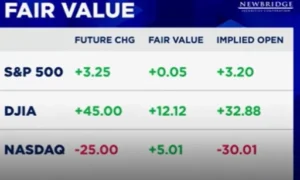Understanding the Producer Price Index (PPI) for September 2024: Key Insights and Implications
The Producer Price Index (PPI) for September 2024 remained unchanged, reflecting a decline in gasoline costs.
2024 In a recent report, the Producer Price Index (PPI) for September 2024 has shown no change from the previous month, primarily driven by a significant decline in gasoline prices. This development is crucial for understanding inflation trends and the broader economic landscape in the United States.
What is the Producer Price Index (PPI)?
 The Producer Price Index measures the average change over time in the selling prices received by domestic producers for their output. It is an essential indicator used to assess inflation at the wholesale level before it reaches consumers. A stable or declining PPI can suggest that consumer prices may not rise as quickly, providing insights into future inflation trends.
The Producer Price Index measures the average change over time in the selling prices received by domestic producers for their output. It is an essential indicator used to assess inflation at the wholesale level before it reaches consumers. A stable or declining PPI can suggest that consumer prices may not rise as quickly, providing insights into future inflation trends.
Key Findings from the September 2024 PPI Report

- Unchanged PPI: The PPI remained flat in September, contrary to expectations of a 0.1% increase according to Dow Jones consensus estimates.
- Gasoline Prices: A notable decline in gasoline costs played a significant role in stabilizing overall producer prices. Gasoline prices fell sharply, reflecting fluctuations in global oil markets and domestic supply chains.
- Core PPI: Excluding food and energy prices, which can be volatile, the core PPI increased by 0.3%. This indicates that while energy costs are stabilizing, other sectors are still experiencing upward price pressure.
Implications of the PPI Data
Economic Outlook
The unchanged PPI provides mixed signals about the economy:
- Inflationary Pressures: The stability in producer prices suggests that inflation may not accelerate as rapidly as some analysts anticipated. However, the increase in core PPI indicates ongoing pressures in other areas of the economy.
- Consumer Impact: If wholesale prices remain stable, consumers may not see significant price increases at retail levels, which could support consumer spending—a critical component of economic growth.
Market Reactions
Financial markets often react to PPI data as it can influence Federal Reserve policy decisions regarding interest rates:
- Interest Rates: With inflation appearing to stabilize, there may be less urgency for the Federal Reserve to raise interest rates aggressively. This could lead to a more favourable borrowing environment for consumers and businesses alike.
- Investor Sentiment: Investors may view this data as a sign that economic conditions are stabilizing, potentially boosting confidence in equities and other asset classes.
Comparative Analysis with Previous Months

To understand the significance of this month’s report, it’s helpful to compare it with previous months:
- August 2024: The PPI rose by 0.2%, indicating some inflationary pressure.
- July 2024: There was a more substantial increase of 0.5%, driven by rising energy costs.
The stabilization seen in September suggests that while there were concerns about rising inflation earlier in the summer, current trends indicate a more balanced approach moving forward.
Conclusion
The unchanged Producer Price Index for September 2024 signals a complex economic landscape where energy prices are stabilizing but core inflation pressures persist. As we move forward, stakeholders—from policymakers to consumers—will need to closely monitor these trends to navigate potential shifts in economic conditions.
For further insights into this developing story and its implications for inflation and economic policy, you can explore more at CNBC, CNN, and Bloomberg. By understanding these dynamics within the PPI report, readers can better appreciate how these economic indicators affect their daily lives and financial decisions.
In a recent report, the Producer Price Index (PPI) for September 2024 has shown no change from the previous month, primarily driven by a significant decline in gasoline prices. This development is crucial for understanding inflation trends and the broader economic landscape in the United States.
What is the Producer Price Index (PPI)?
The Producer Price Index measures the average change over time in the selling prices received by domestic producers for their output. It is an essential indicator used to assess inflation at the wholesale level before it reaches consumers. A stable or declining PPI can suggest that consumer prices may not rise as quickly, providing insights into future inflation trends.
Key Findings from September 2024 PPI Report
- Unchanged PPI: The PPI remained flat in September, contrary to expectations of a 0.1% increase according to Dow Jones consensus estimates.
- Gasoline Prices: A notable decline in gasoline costs played a significant role in stabilizing overall producer prices. Gasoline prices fell sharply, reflecting fluctuations in global oil markets and domestic supply chains.
- Core PPI: Excluding food and energy prices, which can be volatile, the core PPI increased by 0.3%. This indicates that while energy costs are stabilizing, other sectors are still experiencing upward price pressure.
Implications of the PPI Data
Economic Outlook
The unchanged PPI provides mixed signals about the economy:
- Inflationary Pressures: The stability in producer prices suggests that inflation may not accelerate as rapidly as some analysts anticipated. However, the increase in core PPI indicates ongoing pressures in other areas of the economy.
- Consumer Impact: If wholesale prices remain stable, consumers may not see significant price increases at retail levels, which could support consumer spending—a critical component of economic growth.
Market Reactions
Financial markets often react to PPI data as it can influence Federal Reserve policy decisions regarding interest rates:
- Interest Rates: With inflation appearing to stabilize, there may be less urgency for the Federal Reserve to raise interest rates aggressively. This could lead to a more favorable borrowing environment for consumers and businesses alike.
- Investor Sentiment: Investors may view this data as a sign that economic conditions are stabilizing, potentially boosting confidence in equities and other asset classes.
Comparative Analysis with Previous Months
To understand the significance of this month’s report, it’s helpful to compare it with previous months:
- August 2024: The PPI rose by 0.2%, indicating some inflationary pressure.
- July 2024: There was a more substantial increase of 0.5%, driven by rising energy costs.
The stabilization seen in September suggests that while there were concerns about rising inflation earlier in the summer, current trends indicate a more balanced approach moving forward.
Conclusion
The unchanged Producer Price Index for September 2024 signals a complex economic landscape where energy prices are stabilizing but core inflation pressures persist. As we move forward, stakeholders—from policymakers to consumers—will need to closely monitor these trends to navigate potential shifts in economic conditions.For further insights into this developing story and its implications for inflation and economic policy, you can explore more at CNBC, CNN, and Bloomberg.By understanding these dynamics within the PPI report, readers can better appreciate how these economic indicators affect their daily lives and financial decisions.
